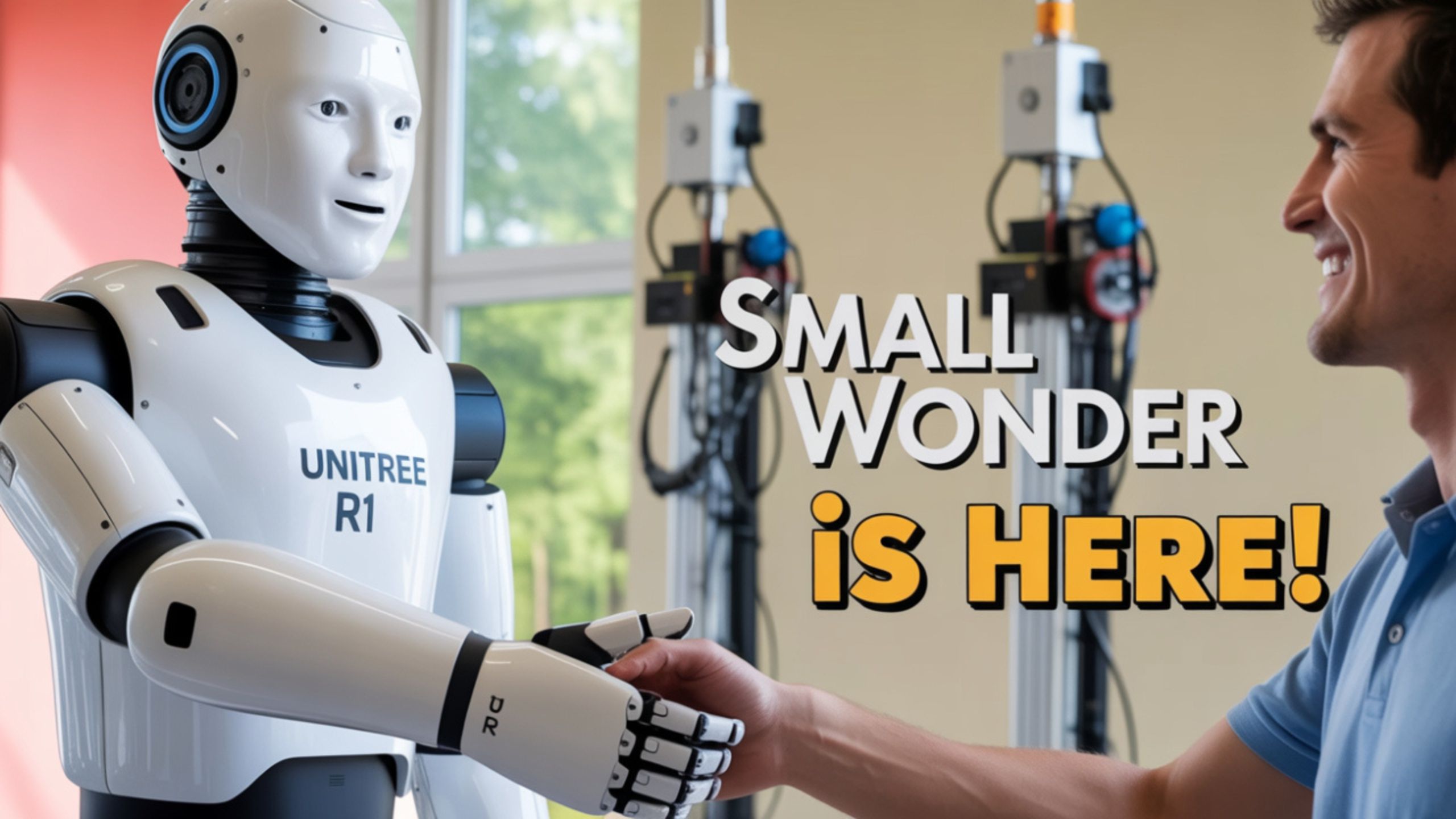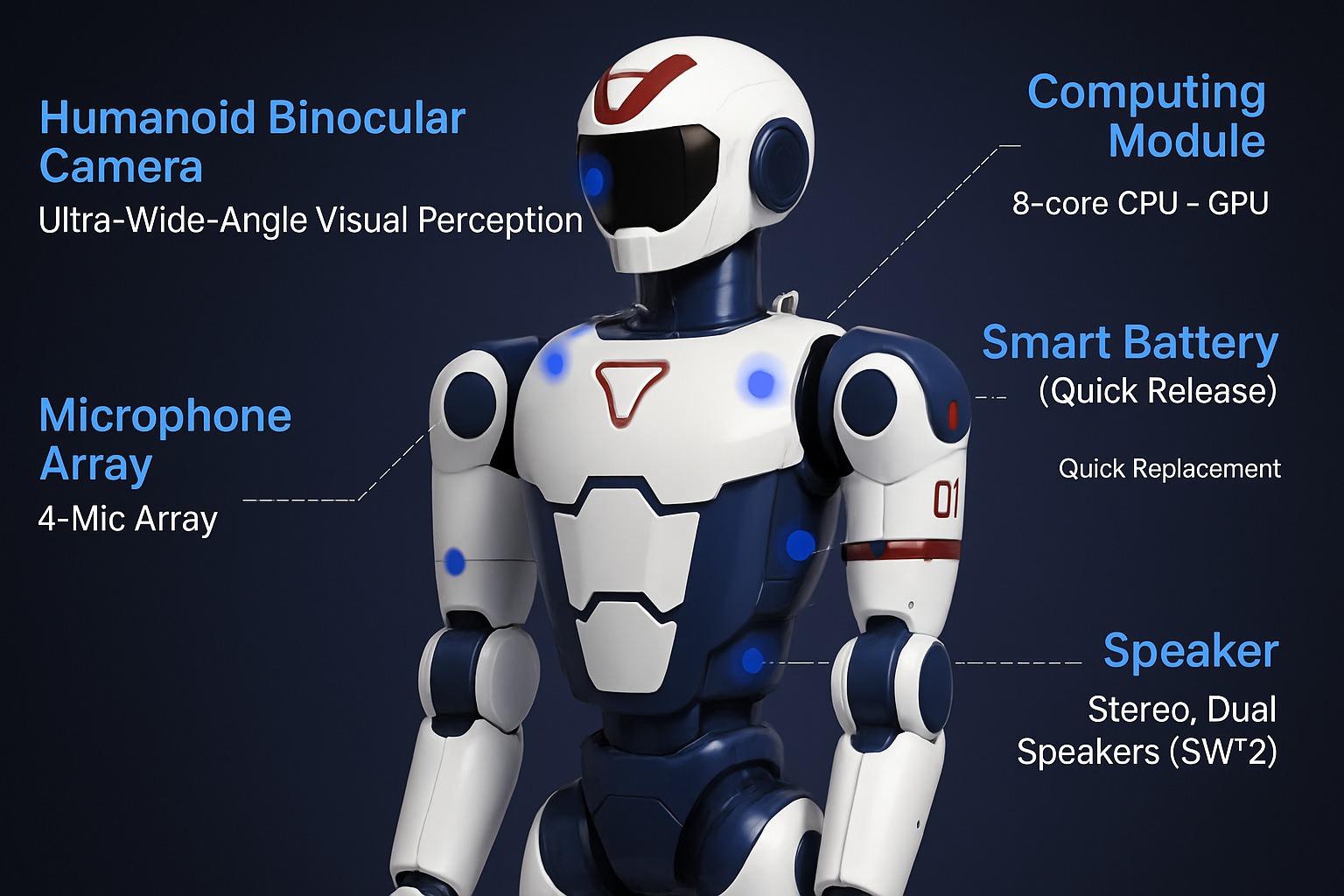In July 2025, the tech world quietly stepped into a new age. Unitree Robotics, already known for its agile quadruped bots, unveiled the Unitree R1, a fully functional humanoid robot priced at just $5,900 (₹5.1 lakh). For the first time in history, a robot that walks, talks, maps, and interacts like a human is within reach of early adopters, tech enthusiasts, and forward-thinking households. This isn’t science fiction—it’s the dawn of consumer humanoid robotics.
Design and Build: A Humanoid with Human-Like Dexterity
The Unitree R1 weighs 25 kilograms and stands at 165 centimeters tall—dimensions nearly identical to the average adult. What makes it stand out isn’t just its shape and remarkable articulation: 26 degrees of freedom, enabling fluid movements, including walking, running, handstands, and even dancing. This mechanical sophistication was once limited to research labs and defense projects.
Its sleek white-and-grey body hides powerful motors, balance sensors, gyroscopes, and a responsive framework that can perform complex motor actions. The humanoid design is not just aesthetic—it’s practical, enabling the R1 to navigate environments built for humans easily.
Advanced AI and Real-Time 3D Vision
At the heart of the R1 is a powerful conversational AI engine, coupled with real-time visual processing capabilities. Using advanced computer vision systems, including depth sensors and 3D LiDAR mapping, the R1 constantly scans its environment, identifies objects, and plans safe and logical paths.
Voice-activated commands allow users to engage with R1 naturally. Want it to fetch a water bottle, read your emails aloud, or remind you about a meeting? Just ask. Its AI learns and adapts, ensuring a personalized and increasingly practical interaction experience over time.
An Open SDK That Empowers Developers
One of the most groundbreaking features is the open SDK (Software Development Kit) provided by Unitree. Developers and researchers can use Python or C++ to code new capabilities, run simulations, and control individual joints or entire behavioral routines. This turns R1 into more than a robot—it becomes a customizable platform for innovation.
Educational institutions, robotics startups, and even hobbyists can now experiment with humanoid robotics at a fraction of the previous costs. R1’s modular structure allows future upgrades, meaning it’s built to evolve with time.
Features That Redefine the Home Robot
The Unitree R1 is packed with an array of features that make it practical, entertaining, and surprisingly useful in everyday scenarios:

- Facial recognition and voice authentication for personalized interactions
- Automated routines, such as turning off lights, checking home temperature, or brewing coffee
- Object recognition and tracking for item fetching and organizing
- Elderly assistance: reaching high shelves, reminding of medication schedules
- Child-friendly mode with interactive learning tools, storytelling, and basic tutoring
- Fitness companion: mirrors yoga poses, counts reps, and gives motivational cues
Comparing the R1 to Other Humanoid Robots

The R1 is the only humanoid robot in this lineup built for real-world consumer use. Its price, openness, and functionality make it a trailblazer in the emerging prosumer robot market.
Applications in Real Life: More Than a Gimmick
The affordability and flexibility of the R1 allow it to adapt to a variety of use cases:
- In households: Acts as an intelligent assistant, entertainment hub, and learning companion.
- In education: Facilitates interactive STEM learning, robotics programming, and AI ethics.
- For businesses: Functions as a greeter, customer service agent, or logistics aide.
- Healthcare environments: Assists in rehabilitation, provides reminders, and reduces caregiver load.
Unlike voice-only assistants like Alexa or Google Assistant, the R1 adds physical presence and motion, making interactions more intuitive and functional.
What Sets Unitree R1 Apart from the Competition
The Unitree R1 isn’t just another tech novelty. It represents the convergence of AI, robotics, and human-centric design. Key differentiators include:
- Affordability: Breaking the six-figure price barrier seen in most humanoids.
- Openness: SDK access encourages third-party development.
- Versatility: Tailored for home, educational, and light commercial environments.
- Agility: Capable of performing gymnastic maneuvers, walking up stairs, and navigating complex terrain.
Cultural Shift: Preparing for Robots in Human Spaces
Beyond the hardware, introducing affordable humanoid robots raises questions about our relationship with machines. How do we build trust? What are the boundaries of service? How should children interact with AI-powered beings?
With R1 entering homes, these abstract ethical and cultural questions will become daily realities. It’s not just about programming robots to understand us—but about teaching ourselves to live alongside intelligent, helpful machines.
Looking Ahead: The Future of Humanoid Integration
As R1 gains traction, expect Unitree to introduce updates, accessories, and a broader robot ecosystem. A humanoid vacuuming your house, cooking dinner, or acting as your child’s tutor might not just be possible—it may become mainstream within the decade.
Forums and developer communities are already buzzing with early modifications and third-party applications. The R1 is more than a robot—it’s a movement and may signal a significant shift in how we think about AI integration in everyday life.

Selva Ganesh is a Computer Science Engineer, Android Developer, and Tech Enthusiast. As the Chief Editor of this blog, he brings over 10 years of experience in Android development and professional blogging. He has completed multiple courses under the Google News Initiative, enhancing his expertise in digital journalism and content accuracy. Selva also manages Android Infotech, a globally recognized platform known for its practical, solution-focused articles that help users resolve Android-related issues.




This is a step forward in making robots part of daily life.
Excited to see the practical uses in education and entertainment.
The R1 is setting new standards in humanoid robotics.
Glad to see fast charging as a feature.
Such a promising product for robotics labs.
Looking forward to integration with smart home devices.
Can’t wait to see what AI applications are built on this platform.
I am amazed by the precision of its movements.
Perfect companion for tech enthusiasts and educators.
Great innovation at an affordable price.
The robot’s voice interaction seems very natural.
Looking forward to reviews from early adopters.
This will definitely boost STEM education.
The community support will be crucial for success.
I appreciate the focus on developer-friendly APIs.
Such a compact humanoid robot with powerful features.
The multi-camera setup must give great vision capabilities.
Hope it will have accessories like dexterous hands soon.
Seeing this robot do acrobatics is fascinating.
Love how it combines fun and advanced tech in one robot.
The price point makes it accessible to a wider audience.
Love the emphasis on AI-powered natural interaction.
Perfect tool for educational and research labs.
The robot’s design is sleek and futuristic.
Excited to see community projects using the R1.
The removable battery is a smart design choice.
Looks like it has a very intuitive control system.
Great job Unitree on making humanoids more accessible.
The R1’s multimodal AI is a game changer in robotics.
I wish the battery lasted longer but still a solid product.
Ideal for developers wanting to prototype interactive AI projects.
Seeing robots perform such movements is always fascinating.
It’s impressive how compact and light the robot is.
The AI integration seems very advanced for its price point.
The open SDK will definitely encourage customization.
Looks like a great investment for tech hobbyists.
This is the future of personal robotics.
Hope the gesture and face recognition work flawlessly.
The educational version with NVIDIA Jetson Orin sounds exciting.
I heard it has 26 joints — really provides human-like movement.
Unitree is changing the game with this affordable humanoid.
Can’t wait to try out the handstand and cartwheel tricks!
The lightweight design makes it easy for home use.
Great to see user-friendly AI and natural language processing combined.
This robot’s mobility is ahead of its competitors.
Interested to see how developers will use the open SDK.
The battery life could be better but still impressive for this price.
Perfect platform for robotics education and research.
The AI capabilities of the R1 make it a great companion for tech enthusiasts.
I love the agility and acrobatic abilities shown by the R1.
Incredible how affordable the Unitree R1 is for a humanoid robot.